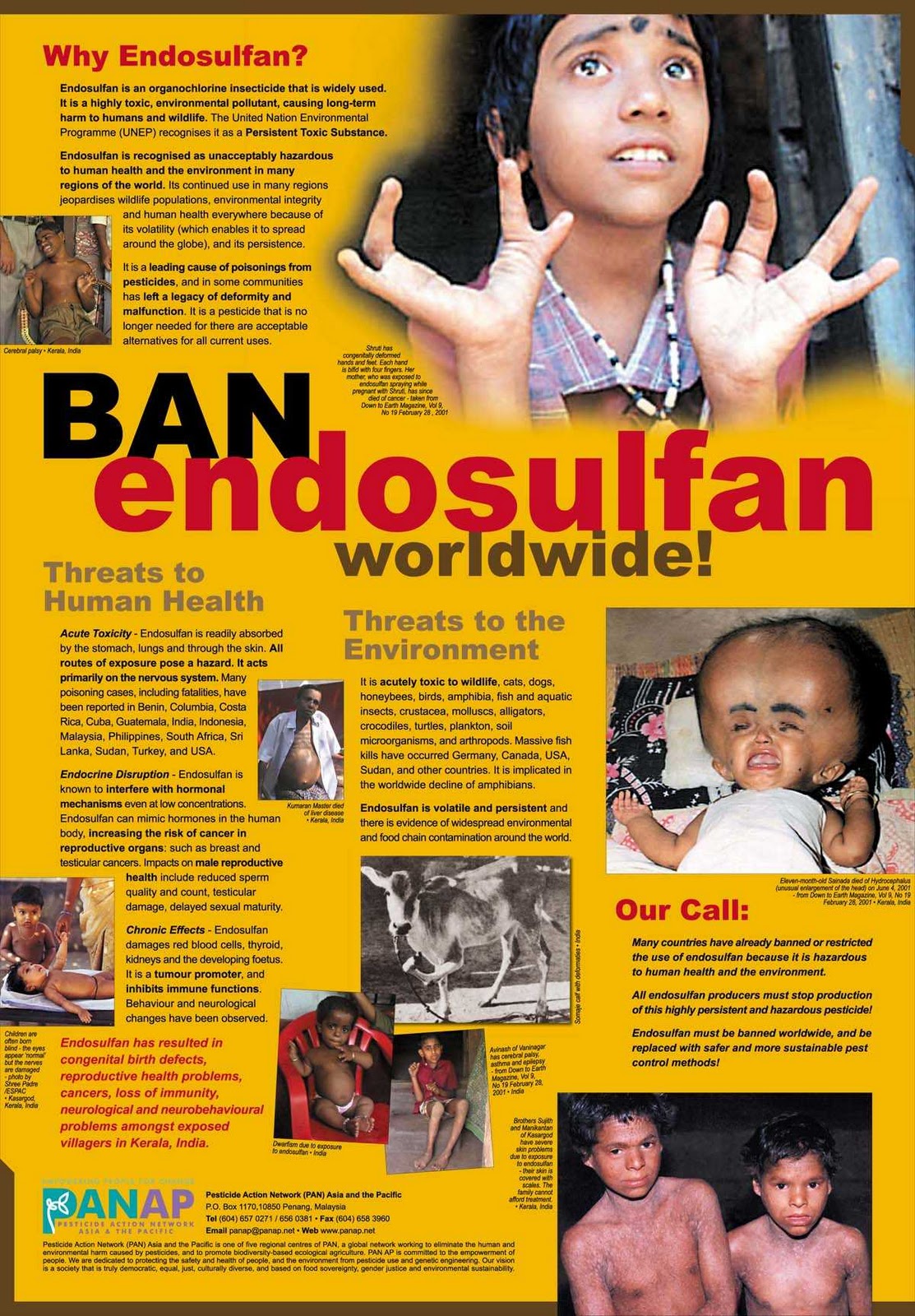Endosulfan
- 6,7,8,9,10,10 - hexachloro- 1,5,5 a, 6,9,9 a- hexahydro- 6,9- methano -2, 4,3 - benzodioxathiepin - 3-oxide (IUPAC)
- Thiodan
- Thionex
- Phaser
- Benzoepin
White crystals with a pungent odor
Fixed
1.75 g · cm -3 ( at 20 ° C)
106 ° C ( 0.9 hPa, decomposition)
Practically insoluble in water: 0.33 mg · l-1 (20 ° C)
Risk
Template: Infobox chemical / molecular formula search available
Endosulfan is a neurotoxic insecticide from the group of bridged bicyclic compounds. It is a chlorinated hydrocarbon containing endo an inner ester of the sulfurous acid ( sulfite ) as the functional group.
Production and Properties
Chemically, it is related to other cyclodiene pesticides such as aldrin, chlordane and heptachlor. Like this it is ( in the case of Endosulfans cis -butene-1 ,4-diol ) is made of hexachlorocyclopentadiene by Diels -Alder reaction and subsequent esterification with thionyl chloride:
Technical endosulfan is a mixture of three stereoisomers. It consists of the two diastereomers α -isomers and β -isomers in the ratio of 7:3, wherein α -isomers present as a racemate. β - endosulfan has a plane of symmetry so is a meso compound. The mechanism of the irreversible isomerization of β -isomers in the racemic α - temperature dependent endosulfan was investigated by spectroscopic methods.
Use
Endosulfan was developed in the early 1950s as an insecticide and 1954 approved by the EPA in favor of Hoechst AG and then used in the agricultural industry. The merger of Hoechst AG with Rhône- Poulenc SA there Bayer CropScience was formed in 1999 to Aventis AG and the sale of agricultural chemicals division Aventis CropScience to Bayer AG, and the product thus endosulfan came to the Bayer Group.
Endosulfan has been used worldwide in agriculture to control harmful insects such as whitefly, aphids, Colorado potato beetle and others. It has been used in addition to the horticulture and in forestry and for controlling the tsetse fly. The World Health Organization estimates that the annual world production was in the early 1980s at about 9000 tons.
The use of Endosulfan is banned in the European Union and in many other countries. However, it is still in countries like China and India in use. In the United States it has been banned since 2010. It was until 2007 by Bayer CropScience and is currently being manufactured by Makhteshim Agan and Hindustan Insecticides and marketed under the trade name Thiodan, Phaser and benzoepin.
Because of the high toxicity and the ability to accumulate in organisms and the environment, a global ban by the Stockholm Convention was aimed at. In April 2011, endosulfan was included in the Annex A of the Stockholm Convention.
In the United States, endosulfan has been approved exclusively for agriculture, where it was in larger quantities in the cultivation of cotton, potatoes, and apples in use. The Environmental Protection Agency (EPA ) estimates that about 700 tonnes of endosulfan were used between 1987 and 1997.
Later, the approval of the compound was gradually withdrawn:
- In 2000, the authorization for private applications by the EPA has been withdrawn.
- The United States Fish and Wildlife Service recommended in 2002 the EPA to end the use of endosulfan. The EPA notes that there is little for children between one and six years of age a risk of acute poisoning due to endosulfan residues in food. The EPA restricted the use then for the agricultural sector, but the admission was made until 2010.
- The international community took steps in 2007 to restrict the use and trade of endosulfan. In the Rotterdam Convention Endosulfan was listed among others as a single substance. The European Commission recommended the inclusion in the list of banned chemicals to the Stockholm Convention. If possible, then the use and production should be banned worldwide. Bayer CropScience took endosulfan in the United States from the market. Other markets, however, remained untouched.
- Several U.S. agricultural associations and scientists demanded the 2008 ban by the EPA.
- In the south of Brazil in 2010 traces of endosulfan were found in organic soy.
- In April 2011, endosulfan was added to the list of POPs in the Stockholm Convention. This results in a global manufacturing and application ban in plant protection products, which should come into force with multi-year transition periods. Such a ban has been planned for 2009, then it failed because of the resistance of India.
Safety
Endosulfan is one of the most toxic pesticides that are still on the market today. It is an estrogenic compound influenced fertility and may cause developmental abnormalities in fetuses from animals and humans. A cancer risk is discussed.
Toxicology
Endosulfan is a neurotoxin to insects, but also for mammals, including humans. The LD50 value was determined to be 30-80 mg / kg. It acts as a GABA antagonist ( γ -aminobutyric acid) on the transmitter gated chloride ion channel. In addition, it inhibits the Ca2 , Mg2 - ATPases. Both effects act on the information within the neuron. Symptoms of acute poisoning include hyperactivity, tremors, convulsions, loss of coordination, difficulty breathing, nausea and vomiting. In severe cases, then enter unconsciousness and death; cases, it has been described that, in the death after a dose of less than 35 mg of human / kg occurred.
Incidents
The Princess of the Stars ferry had ten tons of endosulfan on board when they came on June 22, 2008, Sibuyan in a typhoon and sank. Furthermore the chemical has been associated with a large fish kill in the Rhine on 19 June 1969 in conjunction ( "When the Rhine died ").










